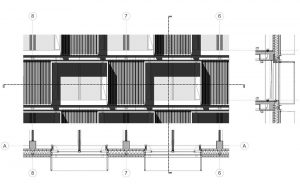Article by: Ar. Alan Kor Loong Lau Published on: Intersection Newsletter 1/2019-2020
The idea that we should visit buildings we admire might seem like a no-brainer. What educator would ever recommend that a few selected views of a famous architectural building could substitute for the actual experience of one? It’s like a chef who advocates that looking at pictures of good food could substitute for the actual tasting of it.
And yet for the vast majority of us, the number of buildings we ever get to experience in person pales with the sheer quantity of buildings that we have “experienced” in images. We are constrained financially and physically from personally visiting all the important and inspirational buildings we know in our minds.
I was in my twenties when I finally visited in person a building which had legendary status. Up to then, all the Architecture (with a big ‘A’) I had ever known was through books and images, a paper city of my own imagination. These famous buildings, or rather the cellulose dot-matrix versions of them, existed unmoored in time and space, complete and unreal. We knew these buildings intimately, every aesthetically-pleasing view, every lovingly photographed angle, even shots that we would never see in real life, courtesy of some ambitious architectural photographer. We knew everything about these buildings without ever having visited them. Or so we thought.
Two buildings which I visited as a student threw these beliefs into the shade. I was lucky – I have parents who believe in travel as a means of education, and these same parents had the means to bring us with them.
The first was the Pantheon in Rome. Like all architecture students, I had been well-schooled in the facts in Architectural History 101. Its virtuoso and early use of concrete. The symbolic use of perfect hemispheres. The subtle positioning of the ceiling coffers. But nothing I had ever read or glimpsed in pictures on the subject prepared me for the real thing.
The shaded entrance portico, a standard temple front, modulates the passage from a busy piazza to a sacred space. The first glimpse of the dome appears as a sliver through those immensely heavy bronze doors, a ticket-shaped glimpse of the cosmos. And then the emergence into a luminous interior infused with a golden light. The noise of the piazza outside recedes away, though the Roman sky is here too, a blue halo harnessed in that famous oculus.
But most transfixing of all, that golden circle of light as it sweeps overhead in a great arc, a pendulum of light slowly swinging across the calibrated coffers, a record of hours, days, centuries, millennia. I stood for an hour, watching time pass. Of all the solid materials in this vast space – bronze, marble, concrete – it is the slow, inexorable passage of Time that weighs heaviest in my memory. And it’s the one thing that no number of photographs can hope to capture.
Sitting on the other end of the time scale, the second great work of architecture I experienced was the Villa Savoye, that seminal Corbusian masterpiece, on the outskirts of Paris. Here, I thought initially, was a building that should feel exactly as it does in photographs. Inured to the image of a work that more closely resembled a pristine, white-card model than an actual building, what further insights could an actual visit bring?
The first thing that strikes you about Villa Savoye is just how small it is. Well, it’s not small small. It was designed as a rich man’s plaything after all. The modern luxury houses that claim descent from it seem pumped on steroids by comparison with their lofty rooms, their oversized spaces, their capacious kitchens. This was nothing like Richard Meier. Here instead was a building that was relatively diminutive in scale, austere even. The ceilings, as in most early modern buildings, were low, the stairs narrow, the fittings perilously close to one’s eyes and head. Most luxury houses nowadays seem to snarl, don’t touch me. This one seems to whisper, touch all you like.
For all of Corbusier’s influence on architectural mass- production, Villa Savoye feels anything but mass-produced. Clearly the overriding aesthetic is that of a modern, industrial world; of ocean liners and airplanes and factories. But here, every fitting is hand-made; every faucet, light fitting, hinge and clothes- hanger bears the nobbly, textured mark of human hands, quite unlike the super-sleek image of modernism we’ve been shown in books. The iPhone owes its design ancestry to the Villa Savoye, but while the former contrives to erase any signs of humanity from its frictionless form, the Villa Savoye lays bare its human origins. The slightly wonky door handles feel like they were forged by a real-life blacksmith, and indeed they probably were.
The thing about these two buildings, or in fact any well-known work of art nowadays, is that their physical reality have been supplanted by countless, reproducible images of them. I use the term “well-known” pointedly. We recognise them from images on the web and from books, we believe we know them. All without ever having seen them in real life. We accept that a 3-dimensional experience (4 if you count time) can be flattened into a 2-dimensional photograph, and that this might be sufficient for understanding, much in the same way that we hope clients will understand our 3D rendering perspectives to represent the real thing. Most of the architecture we know, or will ever know, is a pixelated 2D image of it.
So if you get the chance, go, see it, touch it, experience it.







